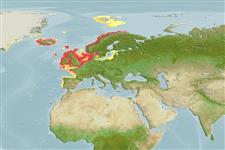Common names from other countries
Classification / Names / Names
Common names | Synonyms | Catalog of Fishes (gen., sp.) | ITIS | CoL | WoRMS
Environment: milieu / climate zone / depth range / distribution range
Ecology
Benthic; depth range 0 - 100 m (Ref. 96312). Temperate, preferred 10°C (Ref. 107945); 81°N - 38°N, 43°W - 30°E
Northeast Atlantic: From Svalbard, UK and the Faeroes, east to the North Sea, Skagerrak and Kattegat to Finnmark, Norway, north to Greenland and Iceland and south to Portugal. Temperate to polar.
Length at first maturity / Size / Weight / Age
Maturity: Lm ? range ? - ? cm Max length : 17.6 cm WD male/unsexed; (Ref. 101443); max. reported age: 8 years (Ref. 101443)
Life cycle and mating behavior
Maturity | Reproduction | Spawning | Eggs | Fecundity | Larvae
Small eggs, seasonally produced, spawning varies with latitude (Ref. 96312).
Harms, J. 1993. (Ref. 2711)
IUCN Red List Status (Ref. 130435: Version 2024-1)
CITES status (Ref. 108899)
Not Evaluated
Not Evaluated
Human uses
Fisheries: commercial
FAO - Fisheries: landings | FishSource | Sea Around Us
Tools
More information
Age/SizeGrowthLength-weightLength-lengthMorphologyLarvaeAbundance
Internet sources
Estimates based on models
Preferred temperature
(Ref.
115969): 7.5 - 12.4, mean 10.3 (based on 538 cells).
Vulnerability
Low to moderate vulnerability (28 of 100).
Price category
Unknown.
